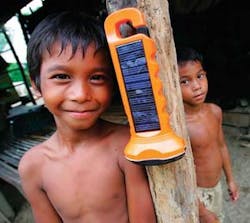SOLAR LEDs: Solar-powered flashlight gets new design for those in need
When John Ellis, president of Optics for Hire (Arlington, MA) read a New York Times story on a U.S. diplomat delivering flashlights to Africans in need, he knew he wanted to help.1 The article of interest was a profile on Mark Bent, a Houston oil consultant and former diplomat to Africa, who noticed while working in Asmara, Eritrea, that villagers had no source of light at night for their homes, schools, or clinics. In 2007, Bent designed a rechargeable, solar-charged flashlight and distributed them to hundreds of Africans.
The flashlight design uses six white-light light-emitting diodes (LEDs) powered via a photovoltaic-rechargeable battery. But the performance of Bent’s first flashlight, designed in China, was lacking. “The reflector was inefficient,” says Bent. “The LED light diverged at an angle of 12º to 15º, but it completely missed the reflector.” The lights have nevertheless been useful for task lighting, such as helping a child read a book. But they weren’t ideal as a source of illumination for a room-a step that would enable major social strides for disadvantaged people.
The redesign of the solar-powered flashlight will incorporate the LEDs with the wider divergence, optimize the layout of the LEDs and the shape of the reflector, as well as minimize glare from the LEDs onto the plastic window.When Ellis called to volunteer his services, Bent asked Optics for Hire to redesign the flashlight, as well as to help design new types of solar-rechargeable lanterns for general illumination. Working with Bent’s Chinese manufacturer, Ellis and his team helped design a ball-shaped device called a Sunball that works like a lantern for hands-free room illumination. The tabletop system incorporates white-light LEDs with a 30º to 40º divergence angle and dome-shaped reflectors that optimize the light. The Sunball is in production and scheduled for availability by early 2008.
The new and improved flashlights can be purchased through a program started by Bent called, “Buy One, Give One,” or BOGO.2 Bent’s company, SunNight Solar, will match each purchase of a BOGO light with another BOGO light for the developing world. SunNight Solar also donates an additional $1 to their network partners for every light sold.
SunNight Solar has distributed thousands of BOGO flashlights to disadvantaged people around the world, like these children in Cambodia. “Because the flashlights are donated and powered by the Sun for free,” says Bent, “the economic benefits to these people are just amazing.” (Courtesy of Karl Grobl and SunNight Solar)
REFERENCES
1. W. Connors and R. Blumenthal, New York Times, “Solar Flashlight Lets Africa’s Sun Deliver the Luxury of Light to the Poorest Villages,” (May 20, 2007).
2. www.sunnightsolar.com

Valerie Coffey-Rosich | Contributing Editor
Valerie Coffey-Rosich is a freelance science and technology writer and editor and a contributing editor for Laser Focus World; she previously served as an Associate Technical Editor (2000-2003) and a Senior Technical Editor (2007-2008) for Laser Focus World.
Valerie holds a BS in physics from the University of Nevada, Reno, and an MA in astronomy from Boston University. She specializes in editing and writing about optics, photonics, astronomy, and physics in academic, reference, and business-to-business publications. In addition to Laser Focus World, her work has appeared online and in print for clients such as the American Institute of Physics, American Heritage Dictionary, BioPhotonics, Encyclopedia Britannica, EuroPhotonics, the Optical Society of America, Photonics Focus, Photonics Spectra, Sky & Telescope, and many others. She is based in Palm Springs, California.
